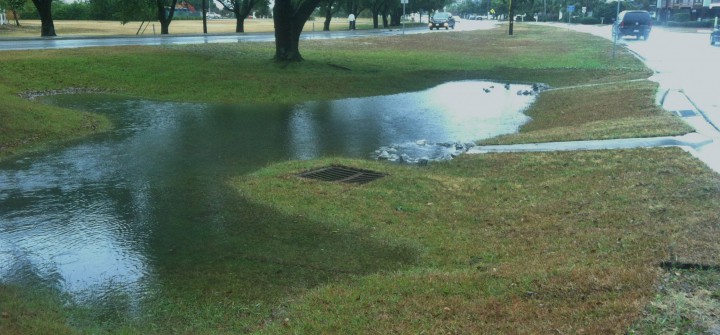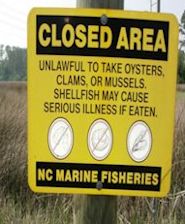
First of two parts
New state stormwater rules are set to be adopted this summer, but it remains unclear how effective the rule changes will be in terms of protecting water quality.
Supporter Spotlight
State officials say the proposed rules mandated by the N.C. General Assembly provide clearer guidelines that are based on the most recent stormwater science, but an environmental advocate says the new rules don’t go far enough to protect shellfish waters and swimming areas.
The public has two remaining opportunities to learn more and comment on the proposed rules. Hearings are scheduled today in Mooresville and Wednesday in Salisbury. The first public hearing was held March 7 at the New Bern-Craven County Library. The public comment period continues through April 18.
The proposed rules continue the legislature’s push for deregulation by authorizing state-licensed professional engineers to design and oversee construction of stormwater systems without state review before construction. It’s part of a fast-track approval process expected to cut permit-approval times from the current 90 days to about a month. Stormwater systems would only be checked for compliance with minimum standards after they are built.

“The whole concept of self-enforcement is an example of a system that hasn’t worked in the past and now we’re getting to use it much more routinely,” said Todd Miller, executive director of the N.C. Coastal Federation.
State officials counter that professional licensing boards will act as a safeguard to ensure design specifications are met. They estimate the proposed rules package will save state residents about $17 million during 2017.
Supporter Spotlight
Miller said the self-enforcement issue is just one of a number of changes that may help businesses and developers but do little to protect highly sensitive coastal waters, especially swimming and shellfish areas, from pollution carried by stormwater runoff. That protection is federally mandated.
“The bottom line is all these programs are supposed to be protecting water quality standards, not economics. Any regulation that allows for routine violations of the law is not sufficient,” Miller said.
Annette Lucas, an engineer with the N.C. Department of Environmental Quality’s stormwater permitting program, disagrees. Lucas said the legislation mandates that water quality waters must be protected. Stakeholders and experts worked exhaustively to agree on design criteria that takes into account the latest stormwater science, she said. Miller also served on the committee.
“They looked at every part of the design criteria to make sure it was protective of water quality and whether they were necessary or not,” Lucas said.
The team included experts from N.C. State University and East Carolina University, Lucas noted.
“They agreed the old criteria were no longer relevant,” she said, adding that the team also agreed the updated rules package was not only more cost-effective but also more protective of water quality.
Legislative Changes
The state’s stormwater management program was launched in the late 1980s. Rules adopted in 2008 added restrictions on new development in coastal counties within a half-mile of high-quality and outstanding resource waters.
The proposed rules, which a state official at the New Bern hearing described as “a reorganization of everything stormwater,” are set to be adopted by July 14. The changes were mandated by a state law passed in 2013 to “impose a less stringent burden on regulated persons,” according to a handout at the meeting, by developing a fast-track permitting process for stormwater systems and establishing minimum design standards for structural stormwater-control measures. The revisions also stem from another 2013 law that directs state agencies to review and update their rules every 10 years.
The rewrites in the proposed rule include efforts to decrease repetition from rule to rule; clarify unclear requirements; incorporate current technology and design standards; improve consistency between the programs; and codify policies that are actually requirements.
For new development in areas within a half mile of shellfish waters, the proposed rules reduce the current capacity requirements for stormwater-control measures from a one-year, 24-hour storm, or more than 3.5 inches in most coastal areas, to a 95th percentile storm depth, or a rainfall event with a precipitation depth greater than or equal to 95 percent of all 24-hour storms on an annual basis. A 95th percentile storm event is about 40 percent less than a one-year, 24-hour storm.
The change also adds the requirement of a sand filter system at the outlet of discharging stormwater-control measure, rather than another stormwater system in series. The result is a net savings for developers. Miller said this change eliminates a long-standing prohibition on discharges of stormwater by allowing the option of treating runoff and discharging it.
“This discharging option should be eliminated from this proposed rule,” according to written comments the federation plans to submit to the state.
Lucas said the change isn’t that different from existing rules.

“Both the old and the new rules do allow some stormwater discharge into SA (shellfishing and recreational) waters but the new rules are more clear – you can only discharge when infiltration is not possible,” Lucas said.
She noted that infiltration is the most effective way to treat stormwater runoff, but it’s not always possible in coastal areas. The proposed rules clarify what must be done in those cases.
“A lot of times on the coast you have good soil but there are situations where the high water table prevents infiltration,” Lucas said. The changes specify what is allowed and what is required in these cases, she said.
The proposed rules also slightly increase the size of the required storm depth for other coastal waters from the 1.5-inch storm to a 90th percentile storm event. This amounts to an increase of about 15 percent more than the 1.5-inch storm, based on the state’s calculations. As far as savings for developers, the change is of minimal effect.
As far as protecting water quality, the changes will “maintain existing environmental protections at an equivalent level,” according to the state.
“If that’s correct then we get more control for the majority of the coastal area, which would more than offset what we’re losing,” Miller said. “Whether that’s sufficient is a huge question. We went to the current design based on the recommendation that water quality was going downhill, based on bacteria levels.”
Changes in hydrology occur because of how people use the land. Most of the problem bacteria that leads to swimming advisories and shellfish closures on the coast are from wildlife. Those bacteria only survive a day or two, so protecting coastal waters is about controlling land uses that have immediate effects on adjacent waters.
Development creates the runoff that carries the pollution, which is a threat to public health.
Miller said the changes may basically be a wash. “The sad thing is, what we had wasn’t adequate, this isn’t adequate,” he said.
The proposed new minimum design standards are to encompass, regardless of location, all requirements defined under the state stormwater program’s best management practices for siting, design, construction and maintenance. These standards are meant to ensure that a stormwater treatment system functions forever to protect water quality standards.
Miller said the flaw in the minimum design criteria is that the capacities specified relate to a single rainfall event and many times rainstorms happen before the stormwater can be absorbed into the earth.
“That’s the fallacy of this storm design, it only captures one rain event. The systems have to draw down before they’re capable of performing at that level again,” Miller said.
Lucas said it would be “very unusual” to have two or more storms of the 90th or 95th percentile intensity within a short period of time. It would be like having back-to-back hurricanes, she said. Most permitted designs should be able to handle their respective rainfall amounts within two or three days.
“Nearly all the time, you should have capacity for the next storm event,” Lucas said.
Tuesday: Fast-Track Permitting







